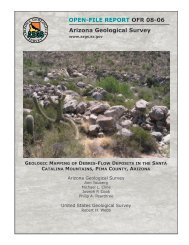geothermal resource potential of the safford-san simon basin, arizona
geothermal resource potential of the safford-san simon basin, arizona
geothermal resource potential of the safford-san simon basin, arizona
You also want an ePaper? Increase the reach of your titles
YUMPU automatically turns print PDFs into web optimized ePapers that Google loves.
Buena Vista Area<br />
Introduction<br />
More than eight irrigation wells, which are all less than 213 meters<br />
deep, discharge <strong>the</strong>rmal water from 30 to 49 0 C.<br />
These <strong>the</strong>rmal waters, previously<br />
reported by Muller and. o<strong>the</strong>rs (1973) as <strong>the</strong> "Larson anomaly", have<br />
sodium chloride-sulfate chemistry with TDS less than 1,200 mg/1 (Table 2).<br />
Three <strong>of</strong> <strong>the</strong>se wells sampled during <strong>the</strong> study have artesian flows which exceed<br />
an estimated 100 gpm during <strong>the</strong> winter months.<br />
Pumped flow rates<br />
measured by <strong>the</strong> U.S. Geological Survey range between 900 and 1,600 gpm (files,<br />
USGS,<br />
Tucson).<br />
Geochemistry<br />
Thermal waters in <strong>the</strong> Buena Vista area are readily distinguished from<br />
local non-<strong>the</strong>rmal waters by <strong>the</strong>ir low calcium «20 mg/1) and magnesium<br />
«8.0 mg/1) concentration and <strong>the</strong>ir high fluoride (>4.0 mg/1) concentrations.<br />
Fluoride concentration up to 14.0 mg/1 are reported for <strong>the</strong>rmal waters in<br />
this area (Figure 9). Dissolved silica in <strong>the</strong>se <strong>the</strong>rmal waters is supersaturated<br />
with respect to quartz and chalcedony at measured discharge temperatures.<br />
Dissolution <strong>of</strong> alumino-silicate minerals is tentatively suggested<br />
as <strong>the</strong> primary control <strong>of</strong> dissolved silica because <strong>the</strong> highest silica concentrations<br />
are observed in waters with <strong>the</strong> highest dissolved carbon dioxide<br />
concentration (Figure 10).<br />
Carbon dioxide reacts with sodium and potassium<br />
feldspars to form clay while adding dissolved sodium, potassium and silica<br />
to ground water (Garrels and Mackenzie, 1967; Stumm and Morgan, 1970).<br />
Subsurface mixing <strong>of</strong> non-<strong>the</strong>rmal waters and <strong>the</strong>rmal waters may occur<br />
because Muller and o<strong>the</strong>rs (1973, p. 55) report a conversation with Mr. Moroni<br />
Larson <strong>of</strong> Solomonsvi11e, who states that wells on <strong>the</strong> "east side <strong>of</strong> <strong>the</strong> road<br />
(San Jose Road) gradually cooled after pumping." This cooling suggests that<br />
37

















